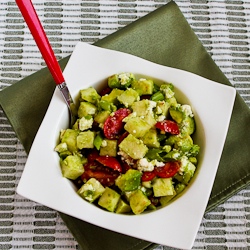Salad Bowl Theory Menu
Spain: Gazpacho
- 3 cups finely diced plum tomatoes, juices reserved
- 2 cups finely diced cucumbers, peeled and seeded
- 1 1/4 cups finely diced onion
- 1 cup finely diced red bell pepper
- 1 tsp minced garlic
- 2 tbsp tomato paste
- 2 tbsp extra-virgin olive oil
- 2 tbsp minced fresh herbs (tarragon, thyme, or parsley)
- 3 cups canned tomato juice
- 1/4 cup red wine vinegar, or as needed
- Juice of 1/2 lemon, or as needed
- 1/4 tsp salt, or as needed
- 1/4 tsp cayenne pepper, or as needed
- 1 cup tiny croutons
- 1/2 cup thinly sliced chives or scallion greens
1. Reserve 2 tablespoons each of the tomatoes, cucumbers, onion, and pepper for the garnish.
2. Puree the remaining tomato, cucumber, onion, and pepper in a food processor or blender along with the garlic, tomato paste, olive oil, and herbs until fairly smooth but with some texture remaining.
3. Transfer the puree to a mixing bowl. Stir in the tomato juice, the red wine vinegar, and lemon juice. Season with salt and cayenne to taste. Cover and chill thoroughly, at least 3 hours but preferably overnight.
4. After chilling, check the seasoning and adjust as needed. Serve in chilled bowls, garnished with the reserved vegetables, croutons, and chives.
Read More http://www.epicurious.com/recipes/food/views/Gazpacho-357151#ixzz2RqOjRWZk
Phillipines: Lumpia

- 3 tablespoons corn, grapeseed, or neutral oil
- 2 garlic cloves, minced
- 2 shallots, minced
- 1 pound pork, chicken, shrimp, or a combination, minced
- 1/2 cup grated or shredded carrot
- 1/2 cup shredded Napa or other cabbage
- 1/2 cup sliced fresh or canned bamboo shoots, drained if canned
- 2 teaspoons salt
- 2 teaspoons black pepper
- 2 teaspoons Shaoxing wine or dry sherry
- 8 Lumpia Wrappers
- 8 green- or red-leaf lettuce leaves
- Sweet Garlic Soy Sauce
1. Put the oil in a large skillet and turn the heat to medium. A minute later, add the garlic and shallots and cook, stirring occasionally, until fragrant, 15 to 30 seconds. Add the pork and cook, breaking up any lumps and stirring occasionally, until the meat loses its pinkness, about 3 minutes. Add the vegetables and cook, stirring occasionally, until softened, about 5 minutes. Add the salt, pepper, and wine and remove from the heat.
2. Lay a lumpia wrapper flat on a work surface and place a piece of the lettuce on top. Line 2 heaping tablespoons of stir-fry mixture on top of the lettuce. Fold in the sides and roll tightly, sealing the seam. If necessary, with a few drops of water spread with a brush or your fingertip. Serve with either or both of the sauces.
Read More http://www.epicurious.com/recipes/food/views/Lumpia-Rolls-352989#ixzz2RqPiwPjD
Italy: Pasta Bolognese
- 2 (28-ounce) cans whole tomatoes with juice or crushed tomatoes
- 3 tablespoons olive oil
- 6 ounces pancetta or 6 slices bacon, finely chopped
- 1/4 pound ground pork (not lean)
- 1/4 pound ground beef chuck (not lean)
- 1/4 pound ground veal
- 1 small onion, finely chopped (about 1 cup)
- 1 carrot, finely chopped (about 1 cup)
- 1 cup dry red wine
- 1 cup heavy cream
- 1 teaspoon kosher salt
- 1 teaspoon freshly ground black pepper
- 1 pound small pasta such as orecchiette or rotini
- Garnish: Freshly grated Parmigiano-Reggiano cheese
If using whole tomatoes, in blender or food processor, purée tomatoes with juice. Set aside.
In large, heavy pot over moderate heat, heat oil until hot but not smoking. Add pancetta and sauté until golden brown, 5 to 6 minutes. Add beef, pork, and veal and sauté, breaking up meat with back of spoon, until browned, 7 to 8 minutes. Add onion and carrot and sauté until vegetables are tender, 5 to 6 minutes.
Stir in red wine and simmer, scraping up browned bits stuck to bottom of pan, until liquid is reduced by half, about 5 minutes. Stir in tomatoes, cream, salt, and pepper. Reduce heat to moderately low and simmer, uncovered, stirring occasionally, until sauce is thickened and brick-red in color, approximately 30 minutes.
In large pot of boiling salted water, cook pasta until almost tender. Drain well and toss with sauce. Serve with grated cheese.
Read More http://www.epicurious.com/recipes/food/views/Pasta-Bolognese-352493#ixzz2RqQeCdqW








